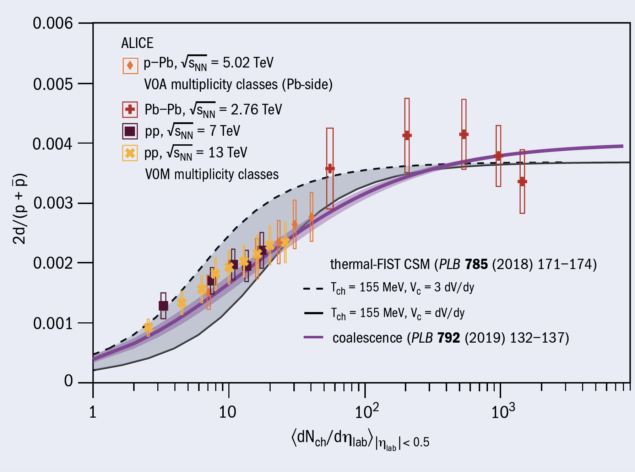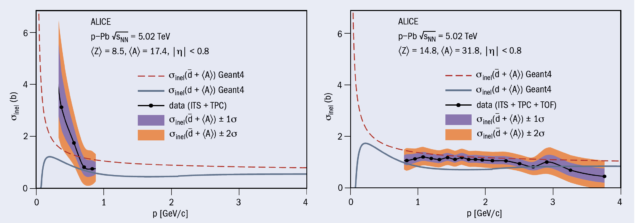Precision measurements of the production and annihilation of light antinuclei at the LHC’s ALICE experiment are sharpening the search for dark matter.
The nature of dark matter (DM) remains one of the most intriguing unsolved questions of modern physics. Astrophysical and cosmological observations suggest that DM accounts for roughly 27% of the mass-energy of the universe, with dark energy comprising 68% and ordinary baryonic matter as described by the Standard Model accounting for a paltry 5%. This massive hole in our understanding of the universe continues to drive multiple experimental searches for DM both in the laboratory and in space. No clear evidence for DM has yet been found, severely constraining the parameter space of the most popular “thermal” DM models.
Assuming DM is a material substance comprised of particles – not an illusion resulting from an imperfect understanding of gravity – there are three independent ways to search for it. One is to directly measure the production of DM particles in a high-energy collider such as the LHC. Another is to infer the presence of DM particles via their scattering off nuclei, as investigated by large underground detectors such as XENON1T and LUX. A third, similarly indirect, strategy is to search for the annihilation or decay of DM particles into ordinary (anti) particles such as positrons or antinuclei – as employed by the AMS experiment on board the International Space Station and in balloon-borne experiments such as GAPS. Low-energy light antinuclei, such as antideuterons and antihelium, are particularly promising signals for such indirect DM searches, since the background stemming from ordinary collisions between cosmic rays and the interstellar medium is expected to be low with respect to the DM signal.
ALICE is the only experiment at the LHC that is able to study the production and annihilation of low-energy antinuclei
The ability to interpret any future observation of antinuclei in our galaxy – especially when trying to identify their creation in exotic processes like DM annihilations – requires a quantitative understanding of light antinuclei production and annihilation mechanisms within the interstellar medium. However, the production of light antinuclei in hadronic collisions between cosmic rays and the interstellar medium is still not fully understood: different models compete to explain how these loosely bound objects can be formed in such high-energy collisions. Furthermore, the inelastic annihilation cross section of light antinuclei with matter is completely unknown in the kinematic region relevant for indirect DM searches, forcing current estimates to rely on extrapolations and modelling.
Fortunately, both the antinuclei production mechanism and the interactions between antinuclei and ordinary matter can be studied on Earth using large accelerators. The main contributions so far have come from the LHC at CERN and from the Relativistic Heavy Ion Collider (RHIC) at Brookhaven National Laboratory. Thanks to its unique low-material-budget tracker, which provides excellent tracking and particle-identification performance for low-momentum particles, ALICE is the only experiment at the LHC that is able to study the production and annihilation of low-energy antinuclei.
Antinucleosynthesis in the lab
While antinuclei can also be produced at lower collision energies, only at the LHC are matter and antimatter generated in equal abundances in the region transverse to the beam direction. The most abundant non-trivial antinucleus produced is the antideuteron, which consists of an antineutron and an antiproton. At low momentum, deuterons and antideuterons can be clearly identified thanks to their high energy loss in the ALICE detector’s time-projection chamber. At larger momenta, a clean identification of antideuterons is possible using the ALICE time-of-flight detector. This information, combined with the measured track length and the particle momentum, provide a precise determination of the particle mass. Using these and other techniques, the ALICE collaboration has recently measured the production of (anti)deuterons in proton–proton collisions, as well as in other colliding systems, and set tight constraints on the production models of (anti)nuclei.

There are two main ways to model the production mechanism of (anti)nuclei. Coalescence models assume that primary (anti)neutrons and (anti)protons can bind if they are close enough in phase space. Statistical hadronisation models, on the other hand, assume that hadrons and (anti) nuclei emerge when the collision system reaches thermodynamical equilibrium, making the temperature and the volume of the system the key parameters. Measurements of nuclei-to-proton ratios in various colliding systems have recently enabled the ALICE collaboration to compare the two model approaches in detail (see “Competing models” figure). As can be seen, the two models give different predictions for the evolution of the nuclei-to-proton ratio versus particle multiplicity, with the latest ALICE measurements slightly favouring the coalescence approach.
Similar conclusions about the two models can be drawn using heavier antinuclei, like 3He and 4He, which were already measured by ALICE in p–Pb and Pb–Pb collisions. The achievable precision of the measurement is limited by the available data: the antinuclei production rate in pp collisions goes down by a factor of about 1000 for every additional antinucleon in the antinucleus.
The precision of the measurements from proton–proton collisions places strong constraints on the production models, which can then be used to predict the antinuclei fluxes in space. Indeed, the ALICE measurements combined with different coalescence models have already been employed to estimate the antideuteron and antihelium flux from cosmic-ray interactions measurable by the AMS and GAPS experiments. These predictions will allow correct interpretations of the eventual antinuclei signal that might be observed in the future by the two collaborations.
Further helping clarify the results of indirect DM searches, ALICE has recently performed the first measurement of the antideuteron inelastic cross section in the momentum range 0.3 < p < 4 GeV/c – significantly extending our knowledge about this cross section from previous measurements at momenta of 13 and 25 GeV/c at the Serpukhov accelerator complex in Russia in the early 1970s. The collaboration took advantage of the ability of antideuterons produced at the LHC to interact inelastically with the detector material. To quantify this process, ALICE has employed a novel approach based on the antideuteron- to-deuteron ratio reconstructed in collisions of protons and heavy ions at a centre-of-mass energy per nucleon–nucleon pair of 5.02 TeV. Such a ratio depends on both of the inelastic cross sections of deuterons and antideuterons. The former has been measured in various previous experiments at different momenta; the latter can be constrained from the ALICE data by comparing the measured ratio with detailed Monte Carlo simulations.

The resulting antideuteron inelastic cross section is shown (see “Interaction probability” figure), where the two panels correspond to the different sub-detectors employed in the analysis and therefore to different average material crossed by (anti)deuterons – corresponding to a difference of about a factor two in average mass number. The inelastic cross sections include all possible inelastic antideuteron processes such as break-up, annihilation or charge exchange, and the analysis procedure was validated by demonstrating consistency with existing antiproton results from traditional scattering experiments.
The momentum range covered is of particular importance to evaluate the signal predictions for indirect dark-matter searches
The momentum range covered in this latest analysis is of particular importance to evaluate the signal predictions for indirect dark-matter searches. Additionally, these measurements can help researchers to understand the low-energy antideuteron inelastic processes and to model better the inelastic antideuteron cross sections in widely-used toolkits such as Geant4. Together with the proper modelling of antinuclei formation, the obtained results will impact the antideuteron flux expectations at low momentum for ongoing and future satellite- and balloon-borne experiments.
The heavier, the better
ALICE is studying the full range of antinuclei physics with unprecedented precision. These results, which have started to emerge only since 2015, are contributing significantly to our understanding of antinuclei formation and annihilation processes, with important ramifications for DM searches. Both the statistical hadronisation and coalescence models can describe antideuteron production at the LHC, while the detector material can be used as an absorber to study the antinuclei inelastic cross section at low energies relevant for the astrophysical applications.
For the foreseeable future, ALICE will continue to provide an essential reference for the interpretation of astrophysics measurements of antinuclei in space. With the increased integrated luminosity that will be acquired by ALICE during LHC Run 3 from early 2022, it will be possible to extend the current analyses to heavier (anti)nuclei, such as 3He and 4He, with even better precision than the currently available measurements for (anti)deuterons. This will allow the collaboration to perform fundamental tests of the production and annihilation mechanisms with heavier, doubly-charged antinuclei, which are more easily identified by satellite-borne experiments and thus expected to provide an even clearer DM signature.
Further reading
ALICE Collab. 2020 Eur. Phys. J. C 80 889.
ALICE Collab. 2020 Phys. Rev. Lett. 125 162001.
ALICE Collab. 2020 Phys. Rev. C 101 044906.
K Blum et al. 2017 Phys. Rev. D 96 103021.
M Korsmeier et al. 2018 Phys. Rev. D 97 103011.
A Shukla et al. 2020 Phys. Rev. D 102 063004.








